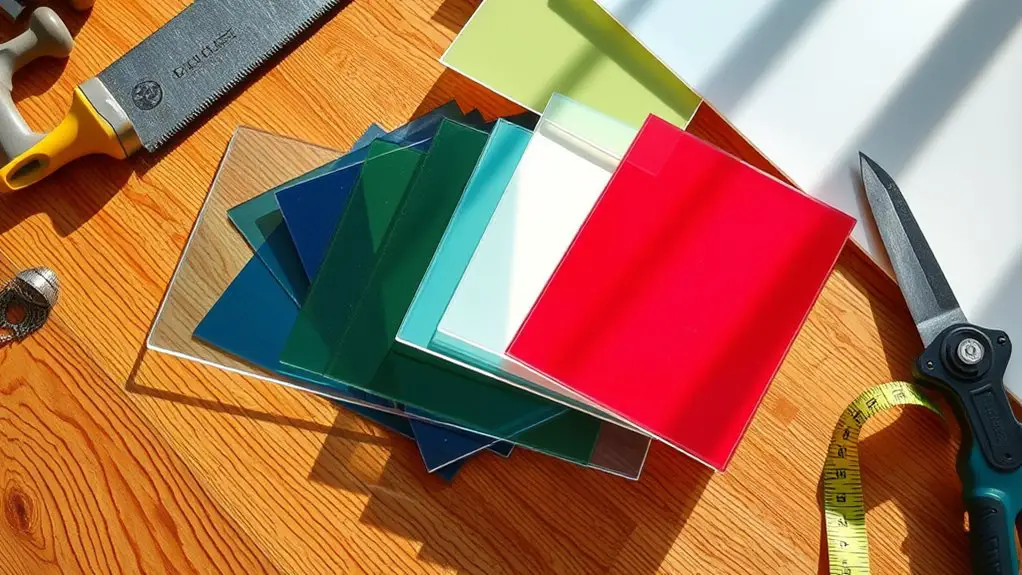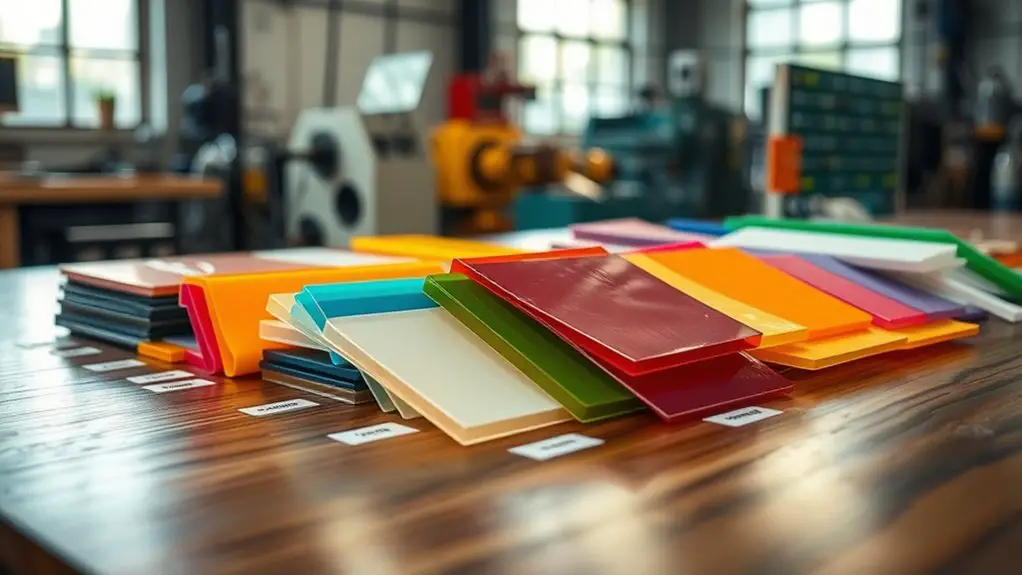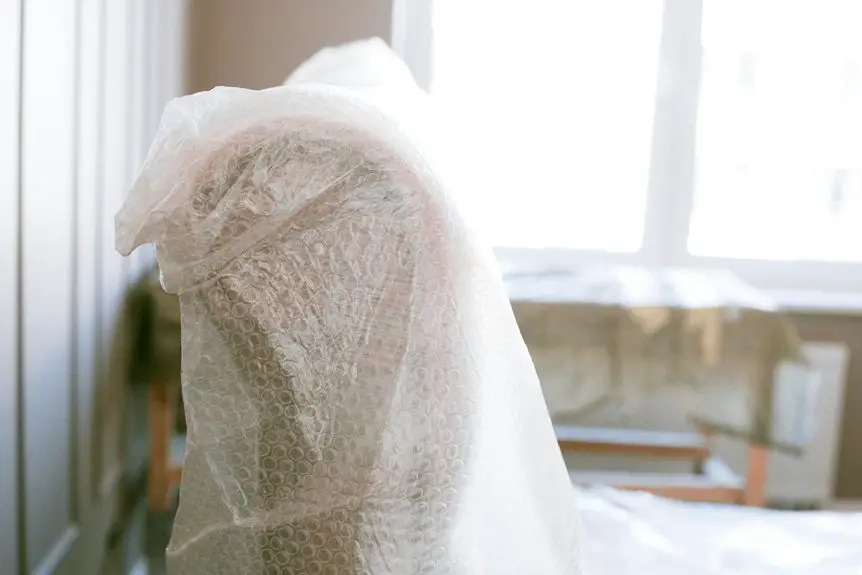When making furniture, you've got several plastic types to consider. Polypropylene (PP) is tough and flexible, perfect for indoor pieces. For high-impact needs, Acrylonitrile Butadiene Styrene (ABS) works well, especially in schools. If you're looking for waterproof options, Polyvinyl Chloride (PVC) fits the bill. For outdoor furniture, High-Density Polyethylene (HDPE) resists the elements. Don't forget about Polycarbonate (PC), which offers a sturdy, glass-like look. Each type brings unique properties suitable for various applications. Explore the fascinating world of plastics to fully understand how they can enhance your furniture projects.
Key Takeaways
- Polypropylene (PP) is versatile, offering toughness and flexibility, making it ideal for a range of indoor furniture applications.
- Acrylonitrile Butadiene Styrene (ABS) provides high impact resistance, making it suitable for durable office and student furniture.
- Polyvinyl Chloride (PVC) is waterproof and fire-resistant, making it versatile for use in homes, schools, and offices.
- Polycarbonate (PC) combines transparency with durability, offering a glass-like aesthetic for high-end furniture designs.
- High-Density Polyethylene (HDPE) is weather-resistant and low maintenance, perfect for outdoor furniture in patios and pool areas.
Types of Plastics in Furniture
When it comes to furniture making, you'll encounter several types of plastics that cater to different needs and environments.
For indoor furniture, polypropylene (PP) stands out due to its toughness, flexibility, and heat resistance. It's lightweight, making it easy to move around, and it's perfect for tables, chairs, and storage units. Additionally, PP is corrosion resistant, enhancing its durability against chemicals and solvents.
Another popular choice is ABS plastic, known for its impact resistance and durability, ideal for office and student furniture.
If you're looking for flexibility in design, PVC plastic is a fantastic option. Its fire-resistant and waterproof properties make it suitable for homes, schools, and offices.
For high-end establishments, polycarbonate (PC) offers a transparent and durable alternative, providing a glass-like appearance while being resistant to impacts and heat.
When it comes to outdoor furniture, high-density polyethylene (HDPE) is a go-to material due to its durability against weather and UV radiation.
It requires low maintenance and is perfect for patios or pool areas. Other options like polyethylene and PVC also cater to outdoor needs, ensuring you have a range of choices that suit various environments and preferences.
Properties of Furniture Plastics
In the realm of furniture making, understanding the properties of various plastics is crucial for selecting the right material for your needs.
Plastics like High-Density Polyethylene (HDPE) and Polypropylene (PP) stand out due to their impressive strength and resilience. Here are some key properties you should consider:
- Impact Resistance: Both HDPE and PP can endure everyday use, making them ideal for high-traffic areas without cracking or splintering.
- Weather Resistance: These plastics resist UV rays and moisture, ensuring they won't fade or degrade when exposed to the elements. Moreover, HDPE and polypropylene are known for their durability in outdoor conditions, enhancing their suitability for patio furniture.
- Low Maintenance: Plastic furniture is easy to clean, requires minimal care, and has a high resistance to stains and scratches. Additionally, many plastic furniture pieces are made from recycled materials, reducing waste and environmental impact.
- Durability and Longevity: With proper care, plastic furniture can last for years, making it a cost-effective option that retains its structural integrity.
When you choose plastics for your furniture, consider these properties to ensure you select materials that will perform well and stand the test of time.
Applications of Plastic Materials

Exploring the applications of plastic materials in furniture making reveals their versatility and practicality across various design needs.
For outdoor furniture, polypropylene (PP) stands out due to its durability and chemical resistance, making it perfect for withstanding harsh weather. Its lightweight nature makes transporting garden chairs and tables hassle-free, and switching to PP can cut production costs by up to 30%. Additionally, its water and UV resistance helps maintain integrity and appearance under sunlight.
You'll also appreciate PP's stackability, which is ideal for portable furniture. Its structural strength ensures stability while remaining easy to clean, a vital feature for commercial settings.
When it comes to aesthetics, PP shines with its ability to mimic wood and accommodate various colors and textures. Plus, its molding capabilities allow for intricate designs, enhancing the visual appeal of your furniture.
Lastly, PP serves essential roles in structural components, creating sturdy frames and surfaces. Its cost efficiency, high impact resistance, and chemical stability make it a reliable choice for functional furniture parts.
Environmental Impact of Plastics
As the furniture industry increasingly embraces plastic materials for their practical benefits, it's important to consider the environmental impact of these choices. By opting for recycled plastic furniture, you're making a positive contribution to the planet.
Here are some significant advantages:
- Reduced Waste: You help divert plastic waste from landfills and oceans, cutting down on pollution and habitat destruction.
- Conservation of Resources: Using recycled plastic diminishes the need for new raw materials, preserving valuable resources like wood and petroleum.
- Lower Energy Consumption: Manufacturing from recycled plastics consumes less energy than producing virgin plastic or other materials, leading to lower carbon emissions. This aligns with sustainability principles that emphasize the importance of reducing resource consumption in construction.
- Extended Material Lifespan: Recycled plastic furniture lasts longer, which not only benefits the environment but also your resource management.
Choosing recycled plastic furniture plays a critical role in mitigating the global plastic crisis, reducing greenhouse gas emissions, and preventing pollution.
Manufacturing Processes in Furniture Making

Efficiency is key in the manufacturing processes of furniture making, where precision and planning lay the groundwork for successful production. You start with design and planning, creating detailed blueprints or 3D models while considering aesthetics, ergonomics, and materials. This stage includes prototype development to test functionality and safety. In 2020, the global furniture production volume was estimated at 450 million units, highlighting the industry's expansive scale.
Once the design is set, materials preparation comes next. You'll cut, shape, and smooth raw materials like wood, metal, and plastic to meet required specifications. After that, it's all about production and assembly. You'll assemble components, join them using various techniques, and incorporate upholstery to enhance comfort.
Finally, finishing and quality control ensure that the furniture meets safety and durability standards. This stage includes applying protective coatings and conducting thorough inspections.
| Stage | Key Activities | Purpose |
|---|---|---|
| Design and Planning | Blueprinting, Prototyping | Establish precise furniture designs |
| Materials Preparation | Cutting, Shaping, Sanding | Prepare materials for assembly |
| Production and Assembly | Joining, Upholstering | Create the final furniture piece |
| Finishing and Quality | Coating, Inspections, Packing | Ensure quality and readiness for shipping
Frequently Asked Questions
How Do I Clean Plastic Furniture Effectively?
To clean plastic furniture effectively, mix ¼ cup of bleach or vinegar with warm water. Use a sponge to scrub, then rinse thoroughly. For routine cleaning, mild detergent works well. Always wear gloves for protection.
Are There Any Health Risks Associated With Plastic Furniture?
Yes, there're health risks associated with plastic furniture. Chemicals like VOCs and phthalates can disrupt hormones, affect indoor air quality, and lead to various health issues, including respiratory problems and developmental disorders. Choose wisely!
Can Plastic Furniture Be Repaired if Damaged?
Yes, you can repair plastic furniture if it's damaged. Use epoxy putty or replacement parts, and ensure you match the materials properly. Following the right steps, you'll restore it effectively and prolong its life.
How Long Does Plastic Furniture Typically Last?
Plastic furniture typically lasts between 5 to 50 years, depending on the type of plastic, environmental exposure, and maintenance. By caring for it properly, you can significantly extend its lifespan and durability.
What Are the Best Practices for Storing Plastic Furniture?
To store plastic furniture, clean it thoroughly, dry it completely, and use breathable materials for wrapping. Ensure a well-ventilated space, avoid direct sunlight, and organize items to prevent damage during retrieval.

